Antibiotic resistant gonorrhea: Difference between revisions
m (Bot: Removing from Primary care) |
|||
| (25 intermediate revisions by 4 users not shown) | |||
| Line 1: | Line 1: | ||
__NOTOC__ | __NOTOC__ | ||
[[Image:Gonorrhea5.jpg|thumb | [[Image:Gonorrhea5.jpg|thumb|200px|right|Drug-resistant N. gonorrhea<ref name="CDCGonorrheapic">Centers for Disease Control and Prevention. Public Health Image Library (PHIL) https://phil.cdc.gov/phil/quicksearch.asp Accessed on September 22, 2016</ref>]] | ||
{{Gonorrhea}} | {{Gonorrhea}} | ||
{{CMG}}; {{AE}} {{SaraM}} | {{CMG}}; {{AE}} {{SaraM}} | ||
==Overview== | ==Overview== | ||
Gonorrhea treatment is complicated by the ability of ''[[Neisseria gonorrhoeae]]'' to develop resistance to antimicrobials. High-level resistance to expanded-spectrum [[cephalosporins]] and [[Azithromycin]] is now reported, and it seems that developing another effective treatment has become financially unattractive for pharmaceutical companies, though new combination antibiotic treatments are being evaluated. There are no affordable alternative therapeutic options currently available for the treatment of gonococcal disease, and it appears that even newly developed [[antibiotics]] will be only a short-term solution, as the bacterium may develop resistance to them as well.<ref name=Gono-resis>Centers for Disease Control and Prevention. Combating the Threat of Antibiotic-Resistant Gonorrhea. (2016) http://www.cdc.gov/std/gonorrhea/arg/carb.htm Accessed on September 25, 2016</ref> | Gonorrhea treatment is complicated by the ability of ''[[Neisseria gonorrhoeae]]'' to develop resistance to antimicrobials. High-level resistance to expanded-spectrum [[cephalosporins]] and [[Azithromycin]] is now reported, and it seems that developing another effective treatment has become financially unattractive for pharmaceutical companies, though new combination antibiotic treatments are being evaluated. There are no affordable alternative therapeutic options currently available for the treatment of gonococcal disease, and it appears that even newly developed [[antibiotics]] will be only a short-term solution, as the bacterium may develop resistance to them as well.<ref name="Gono-resis">Centers for Disease Control and Prevention. Combating the Threat of Antibiotic-Resistant Gonorrhea. (2016) http://www.cdc.gov/std/gonorrhea/arg/carb.htm Accessed on September 25, 2016</ref> | ||
==Antibiotic Resistant== | ==Antibiotic Resistant Gonorrhea== | ||
*Gonorrhea treatment is complicated by the ability of ''[[Neisseria gonorrhoeae]]'' to develop resistance to antimicrobials; accordingly, a combination therapy with [[Azithromycin]] and a [[cephalosporin]] is used to improve treatment efficacy and potentially slow the emergence and spread of antimicrobial resistance. | *Gonorrhea treatment is complicated by the ability of ''[[Neisseria gonorrhoeae]]'' to develop resistance to antimicrobials; accordingly, a combination therapy with [[Azithromycin]] and a [[cephalosporin]] is used to improve treatment efficacy and potentially slow the emergence and spread of antimicrobial resistance. | ||
*High-level resistance to these expanded-spectrum [[cephalosporins]] is now reported, and it seems developing another effective treatment has become unaffordable. | *High-level resistance to these expanded-spectrum [[cephalosporins]] is now reported, and it seems developing another effective treatment has become unaffordable. | ||
| Line 16: | Line 16: | ||
*In 2009, the first extensively drug-resistant (XDR) [[Neisseria gonorrhoeae|gonococcal]] strain (H041) was isolated in Japan.<ref name="pmid21576437">{{cite journal| author=Ohnishi M, Golparian D, Shimuta K, Saika T, Hoshina S, Iwasaku K et al.| title=Is Neisseria gonorrhoeae initiating a future era of untreatable gonorrhea?: detailed characterization of the first strain with high-level resistance to ceftriaxone. | journal=Antimicrob Agents Chemother | year= 2011 | volume= 55 | issue= 7 | pages= 3538-45 | pmid=21576437 | doi=10.1128/AAC.00325-11 | pmc=3122416 | url=https://www.ncbi.nlm.nih.gov/entrez/eutils/elink.fcgi?dbfrom=pubmed&tool=sumsearch.org/cite&retmode=ref&cmd=prlinks&id=21576437 }} </ref> | *In 2009, the first extensively drug-resistant (XDR) [[Neisseria gonorrhoeae|gonococcal]] strain (H041) was isolated in Japan.<ref name="pmid21576437">{{cite journal| author=Ohnishi M, Golparian D, Shimuta K, Saika T, Hoshina S, Iwasaku K et al.| title=Is Neisseria gonorrhoeae initiating a future era of untreatable gonorrhea?: detailed characterization of the first strain with high-level resistance to ceftriaxone. | journal=Antimicrob Agents Chemother | year= 2011 | volume= 55 | issue= 7 | pages= 3538-45 | pmid=21576437 | doi=10.1128/AAC.00325-11 | pmc=3122416 | url=https://www.ncbi.nlm.nih.gov/entrez/eutils/elink.fcgi?dbfrom=pubmed&tool=sumsearch.org/cite&retmode=ref&cmd=prlinks&id=21576437 }} </ref> | ||
*In 2010 to 2011, a second gonococcal strain (F89) with high-level [[cefixime]] and [[ceftriaxone]] resistance was isolated in France and Spain.<ref name="pmid22155830">{{cite journal| author=Unemo M, Golparian D, Nicholas R, Ohnishi M, Gallay A, Sednaoui P| title=High-level cefixime- and ceftriaxone-resistant Neisseria gonorrhoeae in France: novel penA mosaic allele in a successful international clone causes treatment failure. | journal=Antimicrob Agents Chemother | year= 2012 | volume= 56 | issue= 3 | pages= 1273-80 | pmid=22155830 | doi=10.1128/AAC.05760-11 | pmc=3294892 | url=https://www.ncbi.nlm.nih.gov/entrez/eutils/elink.fcgi?dbfrom=pubmed&tool=sumsearch.org/cite&retmode=ref&cmd=prlinks&id=22155830 }} </ref><ref name="pmid22566592">{{cite journal| author=Cámara J, Serra J, Ayats J, Bastida T, Carnicer-Pont D, Andreu A et al.| title=Molecular characterization of two high-level ceftriaxone-resistant Neisseria gonorrhoeae isolates detected in Catalonia, Spain. | journal=J Antimicrob Chemother | year= 2012 | volume= 67 | issue= 8 | pages= 1858-60 | pmid=22566592 | doi=10.1093/jac/dks162 | pmc= | url=https://www.ncbi.nlm.nih.gov/entrez/eutils/elink.fcgi?dbfrom=pubmed&tool=sumsearch.org/cite&retmode=ref&cmd=prlinks&id=22566592 }} </ref> | *In 2010 to 2011, a second gonococcal strain (F89) with high-level [[cefixime]] and [[ceftriaxone]] resistance was isolated in France and Spain.<ref name="pmid22155830">{{cite journal| author=Unemo M, Golparian D, Nicholas R, Ohnishi M, Gallay A, Sednaoui P| title=High-level cefixime- and ceftriaxone-resistant Neisseria gonorrhoeae in France: novel penA mosaic allele in a successful international clone causes treatment failure. | journal=Antimicrob Agents Chemother | year= 2012 | volume= 56 | issue= 3 | pages= 1273-80 | pmid=22155830 | doi=10.1128/AAC.05760-11 | pmc=3294892 | url=https://www.ncbi.nlm.nih.gov/entrez/eutils/elink.fcgi?dbfrom=pubmed&tool=sumsearch.org/cite&retmode=ref&cmd=prlinks&id=22155830 }} </ref><ref name="pmid22566592">{{cite journal| author=Cámara J, Serra J, Ayats J, Bastida T, Carnicer-Pont D, Andreu A et al.| title=Molecular characterization of two high-level ceftriaxone-resistant Neisseria gonorrhoeae isolates detected in Catalonia, Spain. | journal=J Antimicrob Chemother | year= 2012 | volume= 67 | issue= 8 | pages= 1858-60 | pmid=22566592 | doi=10.1093/jac/dks162 | pmc= | url=https://www.ncbi.nlm.nih.gov/entrez/eutils/elink.fcgi?dbfrom=pubmed&tool=sumsearch.org/cite&retmode=ref&cmd=prlinks&id=22566592 }} </ref> | ||
*In 2012, the CDC updated its treatment guidelines, recommending combination therapy with [[ceftriaxone]] and [[azithromycin]].<ref name=CDC-2010> Center of Disease Control, Update to CDC's Sexually Transmitted Diseases Treatment Guidelines, 2010 http://www.cdc.gov/mmwr/preview/mmwrhtml/mm6131a3.htm?s_cid=mm6131a3_w#box Accessed on September 9, 2016 </ref> | *In 2012, the CDC updated its treatment guidelines, recommending combination therapy with [[ceftriaxone]] and [[azithromycin]].<ref name="CDC-2010">Center of Disease Control, Update to CDC's Sexually Transmitted Diseases Treatment Guidelines, 2010 http://www.cdc.gov/mmwr/preview/mmwrhtml/mm6131a3.htm?s_cid=mm6131a3_w#box Accessed on September 9, 2016 </ref> | ||
*In 2014, a [[ceftriaxone]]-resistant gonococcal strain with genetic similarities to H041 was reported in Australia.<ref name="pmid25372111">{{cite journal| author=Lahra MM, Ryder N, Whiley DM| title=A new multidrug-resistant strain of Neisseria gonorrhoeae in Australia. | journal=N Engl J Med | year= 2014 | volume= 371 | issue= 19 | pages= 1850-1 | pmid=25372111 | doi=10.1056/NEJMc1408109 | pmc= | url=https://www.ncbi.nlm.nih.gov/entrez/eutils/elink.fcgi?dbfrom=pubmed&tool=sumsearch.org/cite&retmode=ref&cmd=prlinks&id=25372111 }} </ref> | *In 2014, a [[ceftriaxone]]-resistant gonococcal strain with genetic similarities to H041 was reported in Australia.<ref name="pmid25372111">{{cite journal| author=Lahra MM, Ryder N, Whiley DM| title=A new multidrug-resistant strain of Neisseria gonorrhoeae in Australia. | journal=N Engl J Med | year= 2014 | volume= 371 | issue= 19 | pages= 1850-1 | pmid=25372111 | doi=10.1056/NEJMc1408109 | pmc= | url=https://www.ncbi.nlm.nih.gov/entrez/eutils/elink.fcgi?dbfrom=pubmed&tool=sumsearch.org/cite&retmode=ref&cmd=prlinks&id=25372111 }} </ref> | ||
*In 2015, [[ceftriaxone]] plus [[azithromycin]] became the only recommended treatment for treating gonorrhea.<ref name=Gonorrhea-CDC-2016> Center of Disease Control Addressing the Threat of SHEET Drug-Resistant Gonorrhea https://www.cdc.gov/nchhstp/newsroom/docs/factsheets/drug-resistant-gonorrhea.pdf </ref> | *In 2015, [[ceftriaxone]] plus [[azithromycin]] became the only recommended treatment for treating gonorrhea.<ref name="Gonorrhea-CDC-2016">Center of Disease Control Addressing the Threat of SHEET Drug-Resistant Gonorrhea https://www.cdc.gov/nchhstp/newsroom/docs/factsheets/drug-resistant-gonorrhea.pdf </ref> | ||
'''In 2006, CDC had five recommended treatment options for gonorrhea. Currently, the U.S. has only one option remaining.''' | '''In 2006, CDC had five recommended treatment options for gonorrhea. Currently, the U.S. has only one option remaining.''' | ||
*Although new combination antibiotic treatments are being evaluated, there are currently no affordable alternative therapeutic options currently available for the treatment of gonococcal disease. Further, it seems even newly developed antibiotics will only be short-term solutions, as the bacterium may develop resistance to them as well.<ref name=Gono-resis>Centers for Disease Control and Prevention. Combating the Threat of Antibiotic-Resistant Gonorrhea. (2016) http://www.cdc.gov/std/gonorrhea/arg/carb.htm Accessed on September 25, 2016</ref> | *Although new combination antibiotic treatments are being evaluated, there are currently no affordable alternative therapeutic options currently available for the treatment of gonococcal disease. Further, it seems even newly developed antibiotics will only be short-term solutions, as the bacterium may develop resistance to them as well.<ref name="Gono-resis">Centers for Disease Control and Prevention. Combating the Threat of Antibiotic-Resistant Gonorrhea. (2016) http://www.cdc.gov/std/gonorrhea/arg/carb.htm Accessed on September 25, 2016</ref> | ||
*Drug resistance may be developed through the following mechanisms: | *Drug resistance may be developed through the following mechanisms: | ||
**Chromosomal mutations | **Chromosomal mutations | ||
**Acquisition of R factors ([[plasmids]]) | **Acquisition of R factors ([[plasmids]]) | ||
[[Image:Drug_in_Gonorrhea.jpg|500px|thumb| | [[Image:Drug_in_Gonorrhea.jpg|500px|thumb|left|Source: Centers for disease control: https://www.cdc.gov/]] | ||
<br style="clear:left" /> | |||
{{#ev:youtube|iFwlnljV2Go}} | |||
===Gonococcal Isolate Surveillance Project=== | ===Gonococcal Isolate Surveillance Project=== | ||
Antimicrobial resistance remains an important consideration in the treatment of gonorrhea.<ref name=GISP>GISP, Centers for Disease Control and Prevention. Sexually transmitted disease surveillance 2012; gonococcal isolates surveillance project (GISP) supplement and profiles. Atlanta, GA: U.S. Department of Health and Human Services, 2014.https://www.cdc.gov/std/gisp2012/gisp_2012_text_figures_tables_web.pdf</ref> | [[Antibiotic resistance|Antimicrobial resistance]] remains an important consideration in the treatment of gonorrhea.<ref name="GISP">GISP, Centers for Disease Control and Prevention. Sexually transmitted disease surveillance 2012; gonococcal isolates surveillance project (GISP) supplement and profiles. Atlanta, GA: U.S. Department of Health and Human Services, 2014.https://www.cdc.gov/std/gisp2012/gisp_2012_text_figures_tables_web.pdf</ref> | ||
*In 1986, the CDC established the Gonococcal Isolate Surveillance Project (GISP) | *In 1986, the CDC established the Gonococcal Isolate Surveillance Project (GISP). Data are collected from selected STD clinic sentinel sites and from regional laboratories in order to: <ref name="GISP-2">Schwarcz SK, Zenilman JM, Schnell D, et al. National surveillance of antimicrobial resistance in Neisseria gonorrhoeae. JAMA 1990;264:1413–7. </ref> | ||
**Monitor antimicrobial susceptibility trends in the United States | **Monitor antimicrobial susceptibility trends in the United States | ||
**Characterize male patients with [[gonococcal]] infection | **Characterize male patients with [[gonococcal]] infection | ||
**Phenotypically characterize antimicrobial-resistant isolates of [[Niesseira gonorrhea]] | **Phenotypically characterize antimicrobial-resistant isolates of ''[[Niesseira gonorrhea]]'' | ||
[[Image:Screen_Shot_2016-09-15_at_4.35.56_PM.png|Location of Participating Sentinel Sites and Regional Laboratories, Gonococcal Isolate Surveillance Project (GISP), United States, 2014|500px|thumb| | [[Image:Screen_Shot_2016-09-15_at_4.35.56_PM.png|Location of Participating Sentinel Sites and Regional Laboratories, Gonococcal Isolate Surveillance Project (GISP), United States, 2014|500px|thumb|left|Source: Centers for disease control: https://www.cdc.gov/]] | ||
<br style="clear:left" /> | |||
====Penicillin Susceptibility==== | ====Penicillin Susceptibility==== | ||
[[Penicillin]] has not been a first-line treatment option for gonorrhea for | [[Penicillin]] has not been a first-line treatment option for gonorrhea for several decades. However, it has been tested for surveillance purposes. | ||
*In 2012, | *In 2012, almost 13.1% of ''[[Neisseria gonorrhoeae]]'' from the GISP survey were resistant to penicillin, primarily through two mechanisms: | ||
**Chromosomal penicillin resistance (82.3%) | **Chromosomal penicillin resistance (82.3%) | ||
**[[Penicillinase]] production (17.7%) | **[[Penicillinase]] production (17.7%) | ||
====Ceftriaxone Susceptibility==== | ====Ceftriaxone Susceptibility==== | ||
*In 1987, susceptibility testing for [[ceftriaxone]] began | *In 1987, susceptibility testing for [[ceftriaxone]] began; it is still continued today. | ||
*From 2008 to 2011, ceftriaxone [[Minimum inhibitory concentration|Minimum inhibitory concentrations MICs]] increased from 0.1% to 0.4%. | *From 2008 to 2011, [[ceftriaxone]] [[Minimum inhibitory concentration|Minimum inhibitory concentrations (MICs)]] increased from 0.1% to 0.4%. | ||
* Five isolates with decreased ceftriaxone susceptibility (MIC 0.5 lg/ml) include: | * Five isolates with decreased [[ceftriaxone]] susceptibility (MIC 0.5 lg/ml) include: | ||
**San Diego, California (1987) | **San Diego, California (1987) | ||
**Cincinnati, Ohio (1992 and 1993) | **Cincinnati, Ohio (1992 and 1993) | ||
**Philadelphia, Pennsylvania (1997) | **Philadelphia, Pennsylvania (1997) | ||
**Oklahoma City, Oklahoma (2012) | **Oklahoma City, Oklahoma (2012) | ||
*From 2006–2012, the prevalence of elevated | *From 2006–2012, the prevalence of elevated [[ceftriaxone]] [[Minimum inhibitory concentration|(MICs)]] was higher in isolates from Men Who have | ||
[[Image:NG Percentage of Isolates with Eleveted Ceftriaxone MICs.png|Percentage of Isolates with Elevated Ceftriaxone Minimum Inhibitory Concentrations (MICs) (≥0.125 μg/ml), Gonococcal Isolate Surveillance Project (GISP), 2006–2014)|500px|thumb| | Sex With Men (MSM) than those of Men Who have Sex With Women (MSW). | ||
[[Image:NG Percentage of Isolates with Eleveted Ceftriaxone MICs.png|Percentage of Isolates with Elevated Ceftriaxone Minimum Inhibitory Concentrations (MICs) (≥0.125 μg/ml), Gonococcal Isolate Surveillance Project (GISP), 2006–2014)|500px|thumb|left|Source: Centers for disease control: https://www.cdc.gov/]] | |||
<br style="clear:left" /> | |||
====Cefixime Susceptibility==== | ====Cefixime Susceptibility==== | ||
* | *[[Cefixime]] susceptibility testing began in 1992 and was discontinued in 2007. | ||
*In 2009, [[cefixime]] susceptibility testing was restarted due to | *In 2009, [[cefixime]] susceptibility testing was restarted due to drug supply shortages in the United States. | ||
*From 2006 to 2010, ceftixim [[Minimum inhibitory concentration| | *From 2006 to 2010, ceftixim [[Minimum inhibitory concentration|minimum inhibitory concentrations (MICs)]] increased from 0.1 to 1.4. | ||
* | *From 2006–2012, the prevalence of elevated cefixime (MICs) was higher in isolates from Men Who have | ||
[[Image:NG Percentage of Isolates with Eleveted Cefixime MICs.png|Percentage of Isolates with Elevated Cefixime Minimum Inhibitory Concentrations (MICs) (≥0.25 μg/ml), Gonococcal Isolate Surveillance Project (GISP), 2006–2014|500px|thumb| | Sex With Men (MSM) than from Men Who have Sex With women (MSW). | ||
[[Image:NG Percentage of Isolates with Eleveted Cefixime MICs.png|Percentage of Isolates with Elevated Cefixime Minimum Inhibitory Concentrations (MICs) (≥0.25 μg/ml), Gonococcal Isolate Surveillance Project (GISP), 2006–2014|500px|thumb|left|Source: Centers for disease control: https://www.cdc.gov/]] | |||
<br style="clear:both" /> | |||
====Azithromycin Susceptibility==== | ====Azithromycin Susceptibility==== | ||
| Line 61: | Line 68: | ||
*From 2010 to 2013, the percentage of isolates with reduced azithromycin susceptibility (MICs ≥ 2 μg/ml) ranged from 0.3% to 0.6% | *From 2010 to 2013, the percentage of isolates with reduced azithromycin susceptibility (MICs ≥ 2 μg/ml) ranged from 0.3% to 0.6% | ||
*Between 2013 and 2014, the percentage increased from 0.6% to 2.5% | *Between 2013 and 2014, the percentage increased from 0.6% to 2.5% | ||
[[Image:N G, Distribution of Azitromycin MICs, GISP 2010-2014.png|Neisseria gonorrhoeae — Distribution of Azithromycin Minimum Inhibitory Concentrations (MICs), Gonococcal Isolate Surveillance Project (GISP), 2010–2014|500px|thumb| | [[Image:N G, Distribution of Azitromycin MICs, GISP 2010-2014.png|Neisseria gonorrhoeae — Distribution of Azithromycin Minimum Inhibitory Concentrations (MICs), Gonococcal Isolate Surveillance Project (GISP), 2010–2014|500px|thumb|left|Source: Centers for disease control: https://www.cdc.gov/]] | ||
<br style="clear:both" /> | |||
====Susceptibility to Other Antimicrobials==== | ====Susceptibility to Other Antimicrobials==== | ||
*In 2014, 37.0% of isolates collected from GISP sites were resistant to [[penicillin]], [[tetracycline]], [[ciprofloxacin]], or some combination of those antimicrobials. | *In 2014, 37.0% of isolates collected from GISP sites were resistant to [[penicillin]], [[tetracycline]], [[ciprofloxacin]], or some combination of those [[antimicrobials]]. | ||
[[Image:NG. Precentage of Isolates with PNC, Tetra, And Cipro GISP 2014.png|Neisseria gonorrhoeae — Percentage of Isolates with Penicillin, Tetracycline, and/or Ciprofloxacin Resistance, Gonococcal Isolate Surveillance Project (GISP), 2014|500px|thumb| | [[Image:NG. Precentage of Isolates with PNC, Tetra, And Cipro GISP 2014.png|Neisseria gonorrhoeae — Percentage of Isolates with Penicillin, Tetracycline, and/or Ciprofloxacin Resistance, Gonococcal Isolate Surveillance Project (GISP), 2014; Source: Centers for disease control: https://www.cdc.gov/|500px|thumb|left]] | ||
<br style="clear:both" /> | |||
==References== | ==References== | ||
{{Reflist|2}} | {{Reflist|2}} | ||
{{WH}} | {{WH}} | ||
{{WS}} | {{WS}} | ||
[[Category:Emergency mdicine]] | |||
[[Category:Disease]] | |||
[[Category:Up-To-Date]] | |||
[[Category:Infectious disease]] | |||
[[Category:Rheumatology]] | |||
[[Category:Dermatology]] | |||
[[Category:Gynecology]] | |||
[[Category:Neurology]] | |||
[[Category:Cardiology]] | |||
[[Category:Urology]] | |||
[[Category:Gastroenterology]] | |||
Latest revision as of 20:26, 29 July 2020
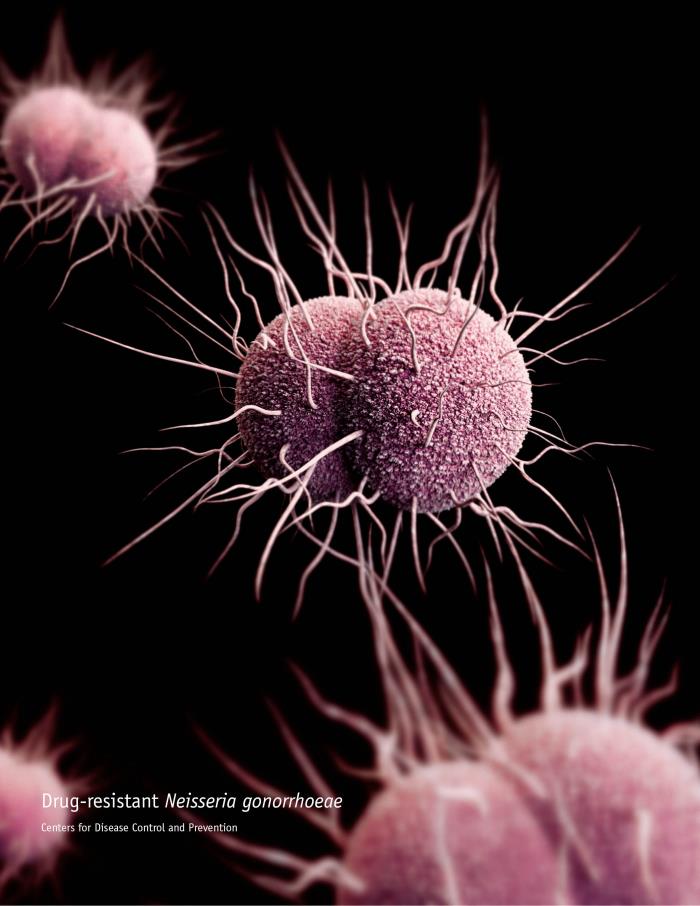
|
Gonorrhea Microchapters |
|
Diagnosis |
|
Treatment |
|
Case Studies |
|
Antibiotic resistant gonorrhea On the Web |
|
American Roentgen Ray Society Images of Antibiotic resistant gonorrhea |
|
Risk calculators and risk factors for Antibiotic resistant gonorrhea |
Editor-In-Chief: C. Michael Gibson, M.S., M.D. [1]; Associate Editor(s)-in-Chief: Sara Mehrsefat, M.D. [2]
Overview
Gonorrhea treatment is complicated by the ability of Neisseria gonorrhoeae to develop resistance to antimicrobials. High-level resistance to expanded-spectrum cephalosporins and Azithromycin is now reported, and it seems that developing another effective treatment has become financially unattractive for pharmaceutical companies, though new combination antibiotic treatments are being evaluated. There are no affordable alternative therapeutic options currently available for the treatment of gonococcal disease, and it appears that even newly developed antibiotics will be only a short-term solution, as the bacterium may develop resistance to them as well.[2]
Antibiotic Resistant Gonorrhea
- Gonorrhea treatment is complicated by the ability of Neisseria gonorrhoeae to develop resistance to antimicrobials; accordingly, a combination therapy with Azithromycin and a cephalosporin is used to improve treatment efficacy and potentially slow the emergence and spread of antimicrobial resistance.
- High-level resistance to these expanded-spectrum cephalosporins is now reported, and it seems developing another effective treatment has become unaffordable.
- In the 1980s, penicillin and tetracycline were no longer recommended to treat gonorrhea.
- Since 1986, the United States Gonococcal Isolate Surveillance Project (GISP) has been monitoring antibiotic resistance to gonorrhea.
- In 2010, it was claimed that 27,000 per 100,000 gonorrhea samples were resistant to penicillin, tetracycline, ciprofloxacin, or some combination of these drugs.
- In 2009, the first extensively drug-resistant (XDR) gonococcal strain (H041) was isolated in Japan.[3]
- In 2010 to 2011, a second gonococcal strain (F89) with high-level cefixime and ceftriaxone resistance was isolated in France and Spain.[4][5]
- In 2012, the CDC updated its treatment guidelines, recommending combination therapy with ceftriaxone and azithromycin.[6]
- In 2014, a ceftriaxone-resistant gonococcal strain with genetic similarities to H041 was reported in Australia.[7]
- In 2015, ceftriaxone plus azithromycin became the only recommended treatment for treating gonorrhea.[8]
In 2006, CDC had five recommended treatment options for gonorrhea. Currently, the U.S. has only one option remaining.
- Although new combination antibiotic treatments are being evaluated, there are currently no affordable alternative therapeutic options currently available for the treatment of gonococcal disease. Further, it seems even newly developed antibiotics will only be short-term solutions, as the bacterium may develop resistance to them as well.[2]
- Drug resistance may be developed through the following mechanisms:
- Chromosomal mutations
- Acquisition of R factors (plasmids)
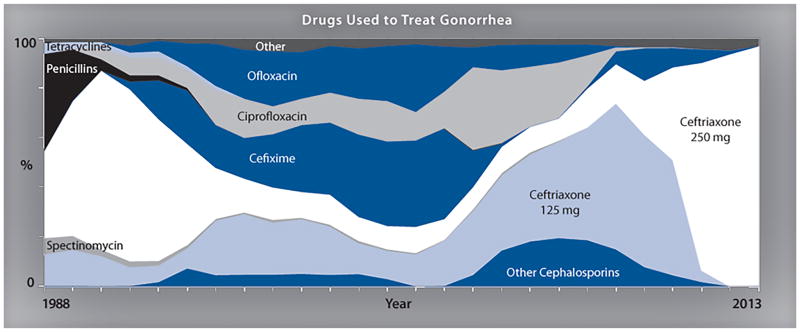
{{#ev:youtube|iFwlnljV2Go}}
Gonococcal Isolate Surveillance Project
Antimicrobial resistance remains an important consideration in the treatment of gonorrhea.[9]
- In 1986, the CDC established the Gonococcal Isolate Surveillance Project (GISP). Data are collected from selected STD clinic sentinel sites and from regional laboratories in order to: [10]
- Monitor antimicrobial susceptibility trends in the United States
- Characterize male patients with gonococcal infection
- Phenotypically characterize antimicrobial-resistant isolates of Niesseira gonorrhea
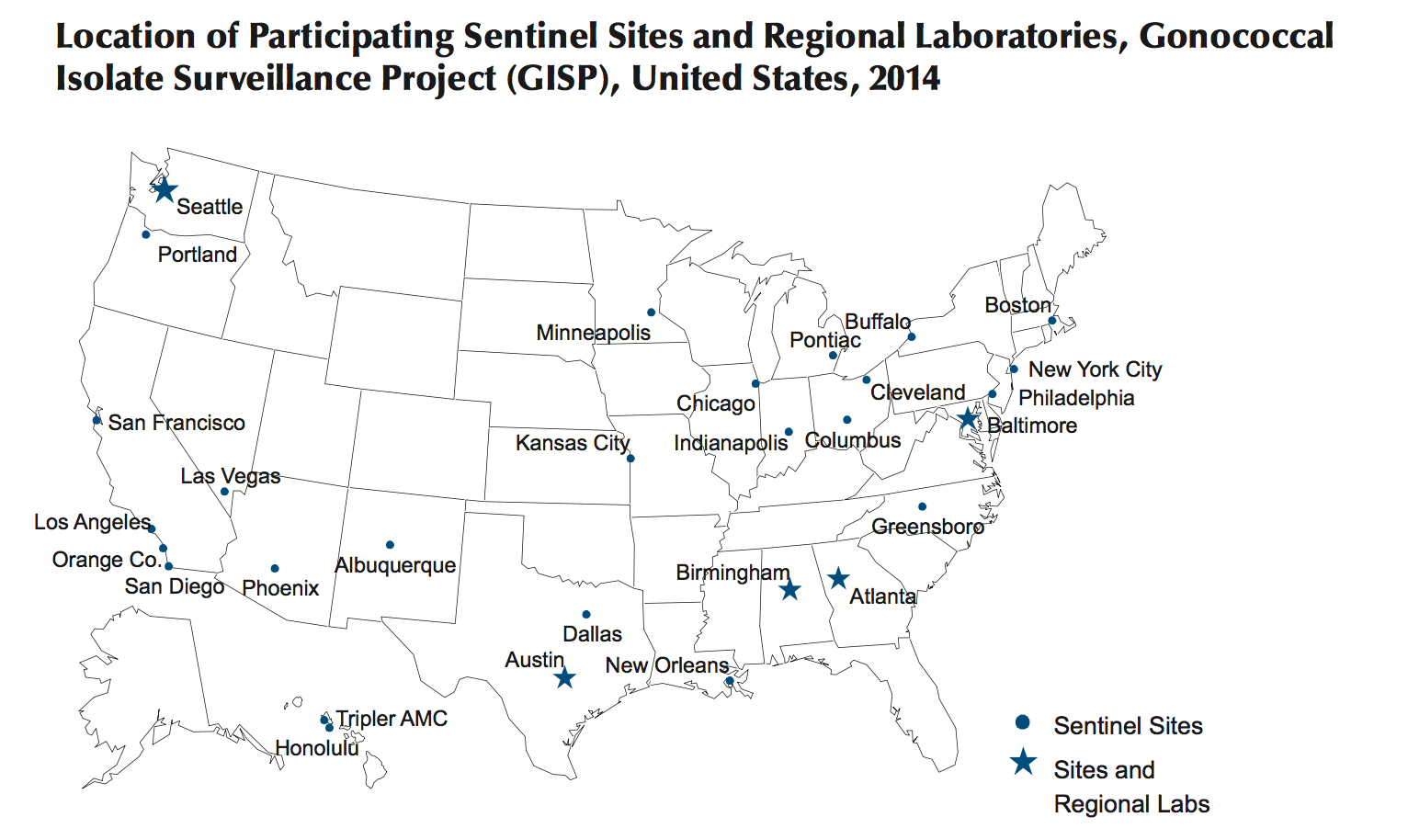
Penicillin Susceptibility
Penicillin has not been a first-line treatment option for gonorrhea for several decades. However, it has been tested for surveillance purposes.
- In 2012, almost 13.1% of Neisseria gonorrhoeae from the GISP survey were resistant to penicillin, primarily through two mechanisms:
- Chromosomal penicillin resistance (82.3%)
- Penicillinase production (17.7%)
Ceftriaxone Susceptibility
- In 1987, susceptibility testing for ceftriaxone began; it is still continued today.
- From 2008 to 2011, ceftriaxone Minimum inhibitory concentrations (MICs) increased from 0.1% to 0.4%.
- Five isolates with decreased ceftriaxone susceptibility (MIC 0.5 lg/ml) include:
- San Diego, California (1987)
- Cincinnati, Ohio (1992 and 1993)
- Philadelphia, Pennsylvania (1997)
- Oklahoma City, Oklahoma (2012)
- From 2006–2012, the prevalence of elevated ceftriaxone (MICs) was higher in isolates from Men Who have
Sex With Men (MSM) than those of Men Who have Sex With Women (MSW).
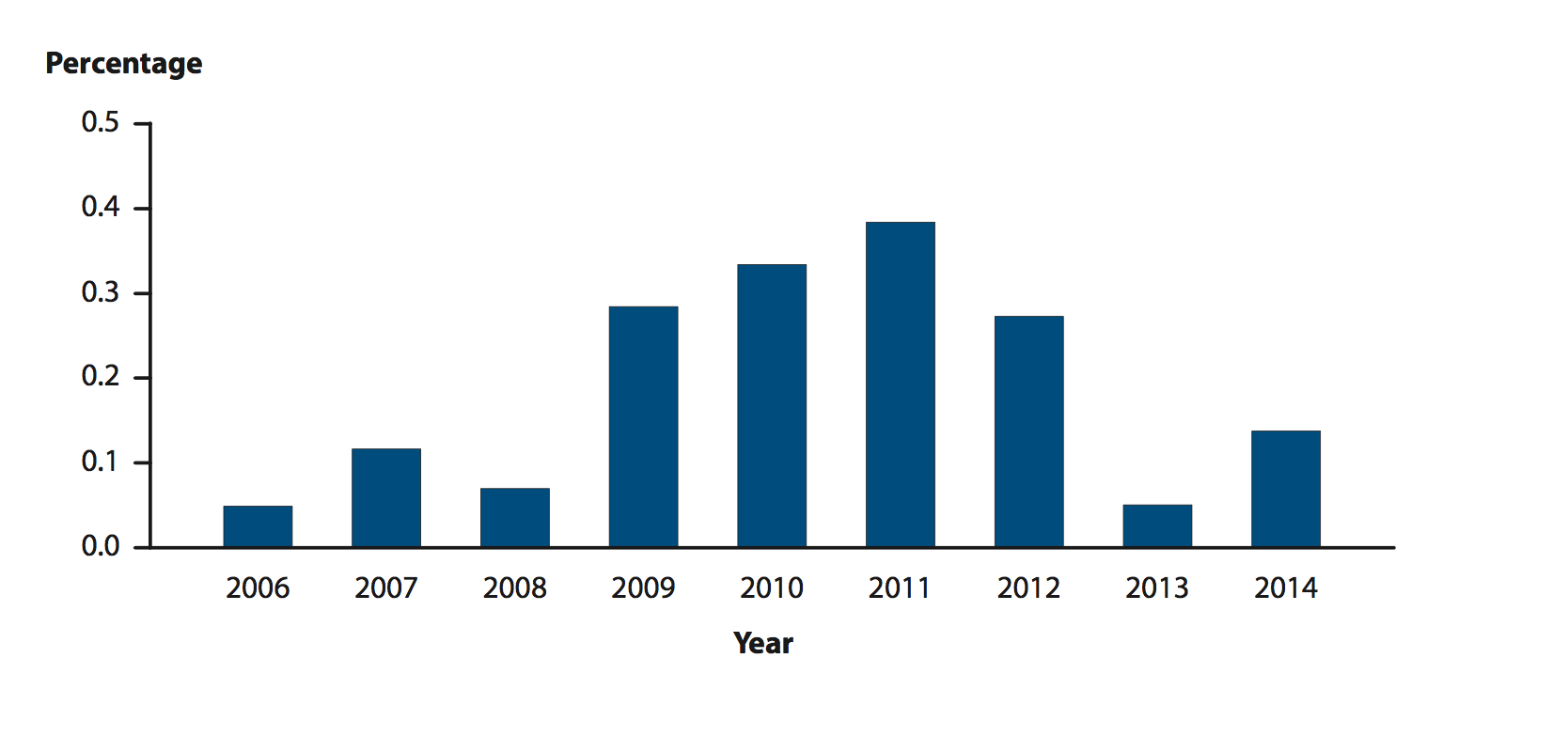
Cefixime Susceptibility
- Cefixime susceptibility testing began in 1992 and was discontinued in 2007.
- In 2009, cefixime susceptibility testing was restarted due to drug supply shortages in the United States.
- From 2006 to 2010, ceftixim minimum inhibitory concentrations (MICs) increased from 0.1 to 1.4.
- From 2006–2012, the prevalence of elevated cefixime (MICs) was higher in isolates from Men Who have
Sex With Men (MSM) than from Men Who have Sex With women (MSW).
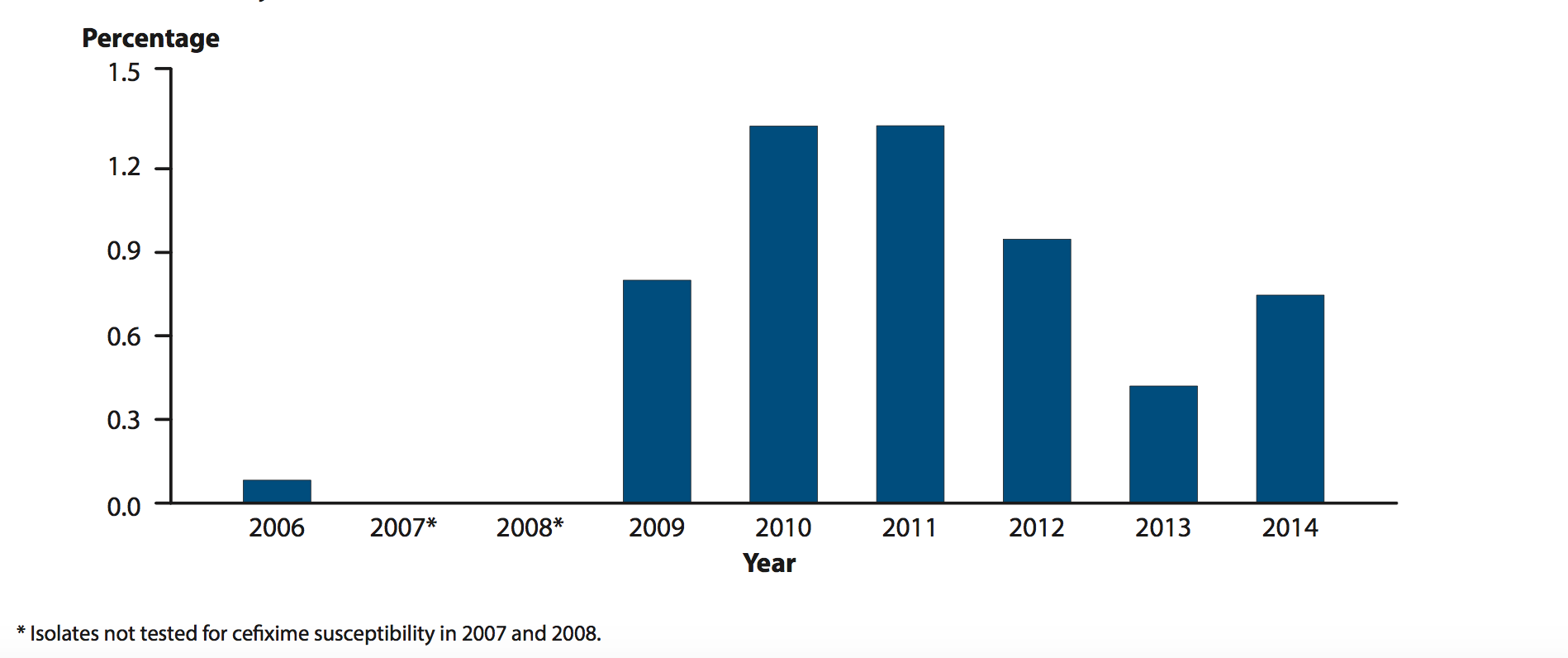
Azithromycin Susceptibility
- In 1992, susceptibility testing for azithromycin began in the United States
- From 2010 to 2013, the percentage of isolates with reduced azithromycin susceptibility (MICs ≥ 2 μg/ml) ranged from 0.3% to 0.6%
- Between 2013 and 2014, the percentage increased from 0.6% to 2.5%
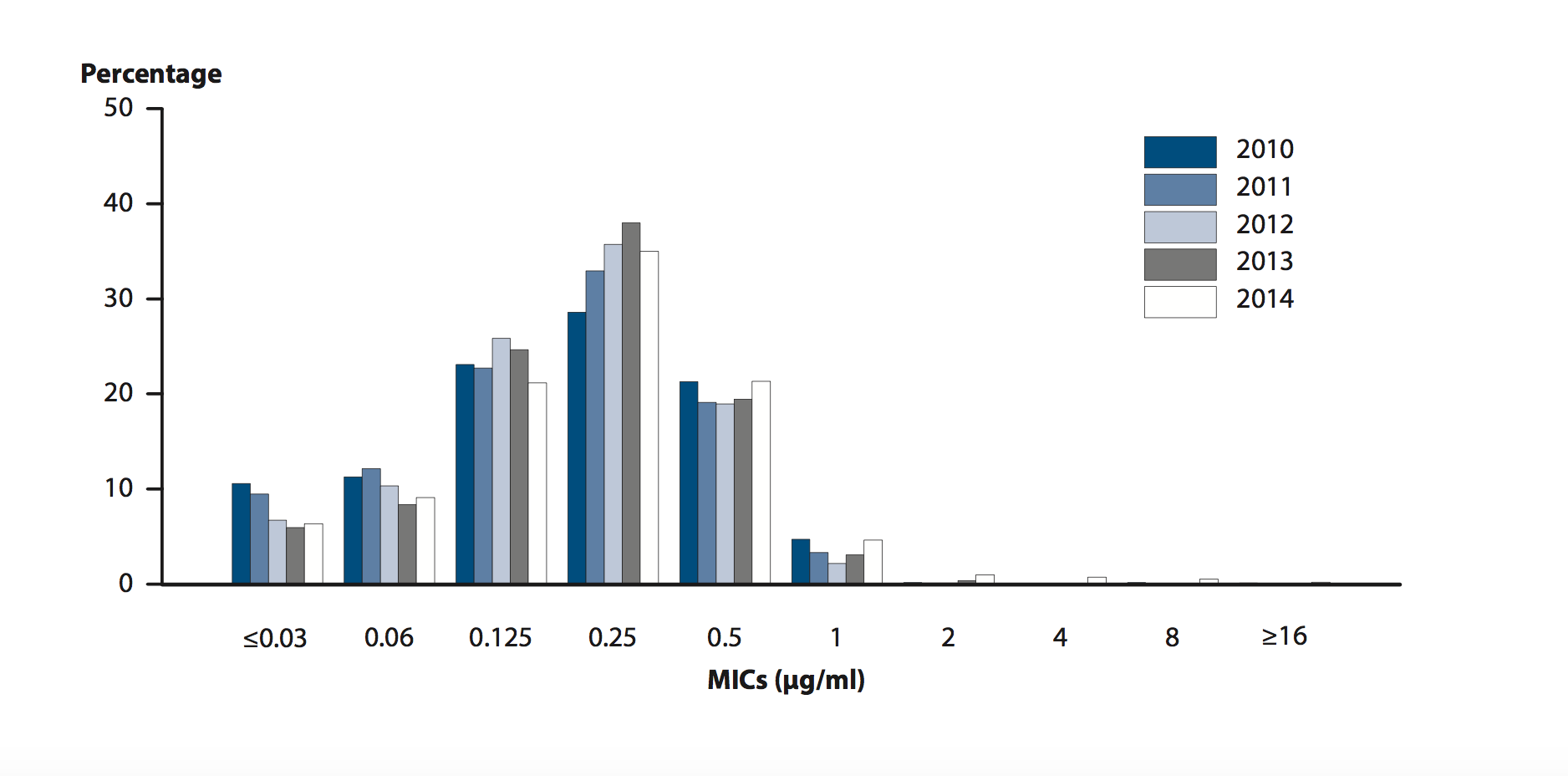
Susceptibility to Other Antimicrobials
- In 2014, 37.0% of isolates collected from GISP sites were resistant to penicillin, tetracycline, ciprofloxacin, or some combination of those antimicrobials.
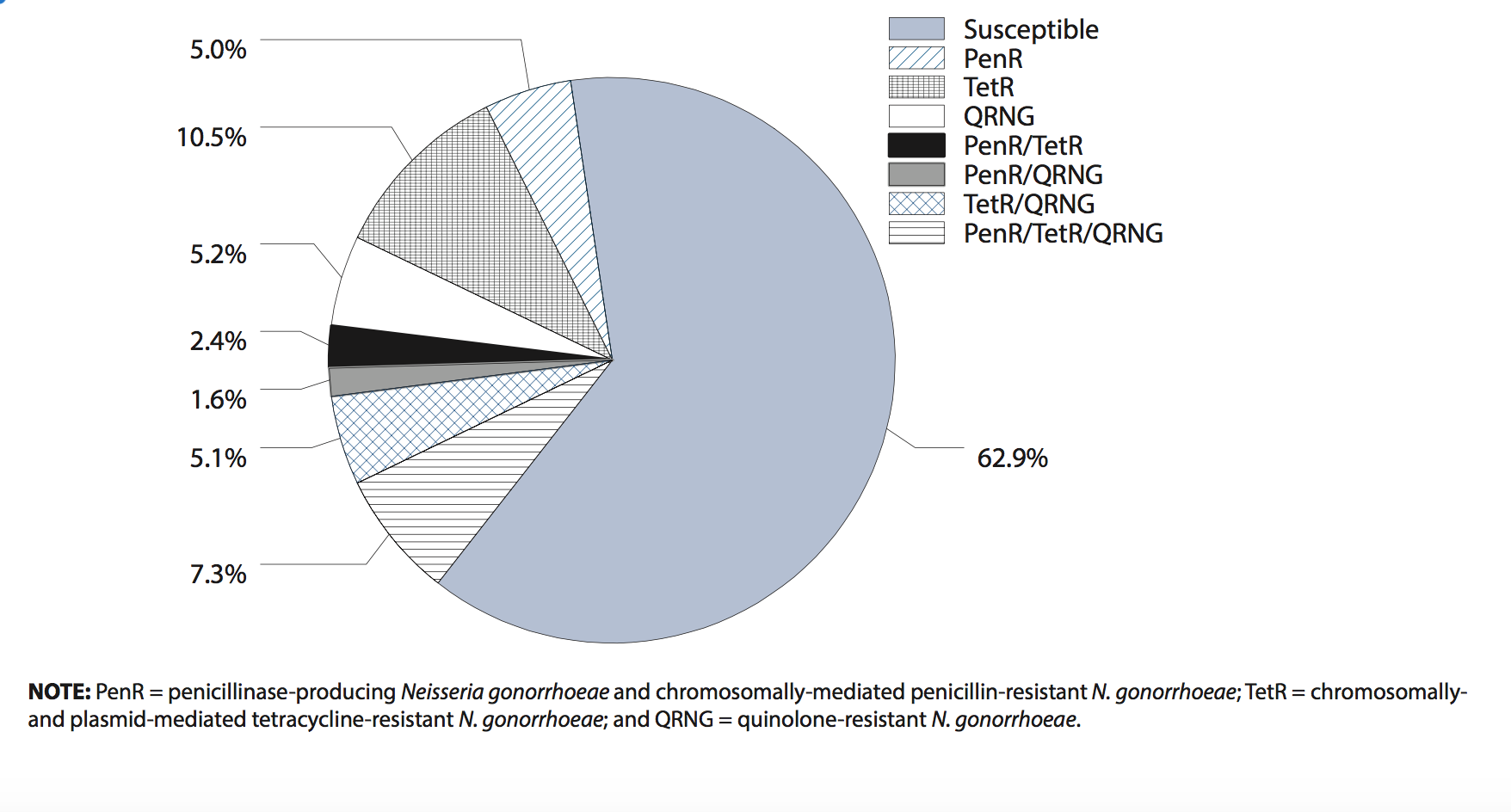
References
- ↑ Centers for Disease Control and Prevention. Public Health Image Library (PHIL) https://phil.cdc.gov/phil/quicksearch.asp Accessed on September 22, 2016
- ↑ 2.0 2.1 Centers for Disease Control and Prevention. Combating the Threat of Antibiotic-Resistant Gonorrhea. (2016) http://www.cdc.gov/std/gonorrhea/arg/carb.htm Accessed on September 25, 2016
- ↑ Ohnishi M, Golparian D, Shimuta K, Saika T, Hoshina S, Iwasaku K; et al. (2011). "Is Neisseria gonorrhoeae initiating a future era of untreatable gonorrhea?: detailed characterization of the first strain with high-level resistance to ceftriaxone". Antimicrob Agents Chemother. 55 (7): 3538–45. doi:10.1128/AAC.00325-11. PMC 3122416. PMID 21576437.
- ↑ Unemo M, Golparian D, Nicholas R, Ohnishi M, Gallay A, Sednaoui P (2012). "High-level cefixime- and ceftriaxone-resistant Neisseria gonorrhoeae in France: novel penA mosaic allele in a successful international clone causes treatment failure". Antimicrob Agents Chemother. 56 (3): 1273–80. doi:10.1128/AAC.05760-11. PMC 3294892. PMID 22155830.
- ↑ Cámara J, Serra J, Ayats J, Bastida T, Carnicer-Pont D, Andreu A; et al. (2012). "Molecular characterization of two high-level ceftriaxone-resistant Neisseria gonorrhoeae isolates detected in Catalonia, Spain". J Antimicrob Chemother. 67 (8): 1858–60. doi:10.1093/jac/dks162. PMID 22566592.
- ↑ Center of Disease Control, Update to CDC's Sexually Transmitted Diseases Treatment Guidelines, 2010 http://www.cdc.gov/mmwr/preview/mmwrhtml/mm6131a3.htm?s_cid=mm6131a3_w#box Accessed on September 9, 2016
- ↑ Lahra MM, Ryder N, Whiley DM (2014). "A new multidrug-resistant strain of Neisseria gonorrhoeae in Australia". N Engl J Med. 371 (19): 1850–1. doi:10.1056/NEJMc1408109. PMID 25372111.
- ↑ Center of Disease Control Addressing the Threat of SHEET Drug-Resistant Gonorrhea https://www.cdc.gov/nchhstp/newsroom/docs/factsheets/drug-resistant-gonorrhea.pdf
- ↑ GISP, Centers for Disease Control and Prevention. Sexually transmitted disease surveillance 2012; gonococcal isolates surveillance project (GISP) supplement and profiles. Atlanta, GA: U.S. Department of Health and Human Services, 2014.https://www.cdc.gov/std/gisp2012/gisp_2012_text_figures_tables_web.pdf
- ↑ Schwarcz SK, Zenilman JM, Schnell D, et al. National surveillance of antimicrobial resistance in Neisseria gonorrhoeae. JAMA 1990;264:1413–7.